RO systems are used for purifying water and delivering clean, safe drinking water. However, their environmental effect must be discussed. RO systems remove pollutants and improve flavor, but they waste water and energy. This article will examine reverse osmosis systems’ water, energy, and environmental impacts and possible solutions.
Water Waste: A Major Issue
The quantity of water reverse osmosis water filters waste during purification is a major environmental issue. The traditional RO systems use a permeate-to-reject ratio. RO systems waste three to four liters of water every gallon of the filtered water. This excessive use of water is alarming, especially in regions where water resources are scarce. This waste could contaminate the environment and community in locations with limited freshwater. After a certain period, unchecked RO water supply could eventually drain the aquifers and disrupt local ecological systems. Because RO systems produce such a massive amount of wastewater, users and manufacturers have to manage this waste. Access to clean water is life.
Carbon Footprint and Energy Consumption
Besides water wastage, the amount of energy utilized by reverse osmosis systems also comes into consideration regarding environment. Besides the enormous industrial systems, home-based RO systems are still requiring electricity for pumping mechanisms that filter their water. This source of energy often impacts the system’s environmental footprint. Energy-intensive power generation systems utilizing fossil fuel increase the level of greenhouse gas emissions in many countries. Therefore, RO water purifiers would likely have a greater carbon footprint than anticipated, especially if scaled up to thousands of homes. Energy efficiency gains in these systems could reduce the environmental impact, but it depends on local grid energy sources.
Filter Membrane Waste Management issues
The environmental impacts of a reverse osmosis system go beyond water and energy usage. Several filter membrane issues are also concerned with other waste management. Because the membrane needs to be changed every two to three years, this system is prone to massive waste generation.
Synthetic polymers in RO membranes do not biodegrade quickly, and hence, their disposal is environmentally hazardous. Thereby, landfilling these products can be a source of long term environmental damage. This further raises questions regarding the sustainability of RO technology. Biodegradable membranes or membrane recycling schemes may overcome these challenges and make water treatment even greener.
Impact against other filtration systems
Alternative water filtering methods must be put into perspective while evaluating the environmental impact of reverse osmosis. Activated carbon filters, UV purification, and distillation have different environmental footprints and may solve certain problems of an RO system. For example, activated carbon filters produce less effluent and consume less energy.
Alternatives to RO systems typically retain a higher mineral content in water, that is beneficial to flavor and health, but eliminates the complications of waste management. Selecting an effective, environmental friendly filtering technology will be crucial since water quality and customer preferences vary. In most situations, the less energy- and water-demanding options may better suit consumer demands and environmental requirements.
RO Technology Advancements and Future
Because reverse osmosis technology affects the environment, researchers and businesses have been putting much efforts to improve this technology. Currently, the technology is available to enhance system efficiency, minimize water waste, and utilize renewable energy. Advanced membranes characterize improved permeability that filters with less energy, thus minimizing waste and power usage.
Conclusion:
In conclusion, reverse osmosis water filters do well in purifying drinking water, but waste water, energy, and waste are wasted through the system. Consumers must consider their water demands and environmental effect to decide whether these systems are eco-friendly.

